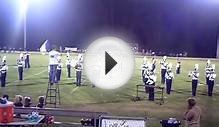
Marching Band Music
Please learn, memorize and be comfortable with the exercises and rudiments in this packet. These exercises and rudiments are responsible for developing a specific musical and technical requirement that is inherent in the successful performance of the music. Everyone interested in playing bass drum and cymbals will audition on snare drum using match grip and should prepare
the snare drum part, as many rudiments as possible and be ready to sight read. Those interested in trying out for snare drum should use traditional grip. Those of you interested in tenors, be prepared to play the entire part on the second drum in addition to the split, if given. We understand that for many of you, percussion may not be your first instrument, please do your best and try to learn as much of the snare part as possible.
Approach
The approach is the concept behind the sound and the visual presentation. In marching percussion, the visual aspect of producing sound is as important as the sound itself. If it looks good, it probably sounds good. It is therefore important to understand and develop a uniform technique.
Each of the exercises in this packet should be practiced slowly and gradually sped up. Practicing the exercises slowly allows you (us) the ability to accurately execute the correct rhythms, stickings, dynamics, and pitches. I suggest spending the majority of your practice time with a metronome at the low end of the tempo range in front of a mirror.
For most battery exercises a dynamic marking will be given which is defined by the highest point of the stroke in inches. General rule of thumb for accent/tap playing is 6″ of difference between accented and unaccented notes. Example: ff playing would be 12″ accent height and 6″ unaccented height. Below is how the stick heights correspond with the written dynamics. Mallet players should practice the exercises at all dynamic levels.
fff – 15’’ full wrist/arm extension – stick is at a 90 degree angle to the drum head
ff – 12’’
f – 9’’
mf – 6’’
mp – 3’’
p – 1 ½’’
Things to listen, look and feel in your playing:
- Accurate playing of the part – rhythms, pitches, stickings, dynamics/heights/accents.
- Consistent Tempo – use your ears and your metronome. Record yourself – you’ll be amazed at what you hear.
YOU MIGHT ALSO LIKE



Share this Post
Related posts
Marching Band Music video
Nathanial Kenner, Rashad Dillon, Josh Brown and Lawjahn Johnson didn t know a clip of them dancing would make it into a music…
Read MoreMarching Band Music Downloads
The University of West Georgia Marching Band - The Sound that Lights the South - is open to all UWG wind, percussion and…
Read More










